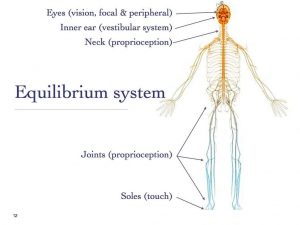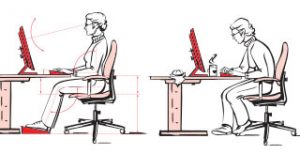- New Patient Line:
- (907) 336-0200
When you’re experiencing vertigo there is a problem with the signals your brain is receiving from the equilibrium and position-sensing systems in your body.
When you’re experiencing vertigo there is a problem with the signals your brain is receiving from the equilibrium and position- sensing systems in your body. Usually we’re considering visual input, sensory input from receptors in joints and connective tissue, and a part of the inner ear called the labyrinth.
sensing systems in your body. Usually we’re considering visual input, sensory input from receptors in joints and connective tissue, and a part of the inner ear called the labyrinth.
The labyrinth in the inner allows you to recognize where your head is in space compared to gravity. For example, if your eyes are closed you can tell if you’re upright, upside-down, or on your side. If there’s a problem with the labyrinth itself, a medical specialist that deals with the inner ear will usually be able to detect this by using a diagnostic test like the Dix-Hallpike maneuver. In these cases something like the Epley maneuver may be all it takes to solve the problem. Often though, the problem isn’t so easily solved.
This is when we need to start considering the upper-cervical spine and the impact it can have on the neurological integrity of equilibrium and position-sense.
- The 8th Cranial Nerve transmits the information from the labyrinth in the inner ear to central nervous system, and is located near the upper-cervical spine.
- The largest and most important sensory input for equilibrium comes from the upper-cervical spine. This input is responsible for the position-sense between the head and body, also known as proprioception. Close your eyes and turn your head left or right—your finger can find your nose even with your eyes closed because of this type of sensory integration.
- These same neck proprioceptors have reflex effects on the visual apparatus, which is another important piece of the puzzle when considering vertigo and disorientation.
- Each structural component involved in maintaining equilibrium requires adequate circulation in order to function properly, and evidence suggests that changes in upper-cervical alignment negatively affect normal circulatory regulation.
When accidents and injuries disturb the normal alignment between the head and the atlas, the proprioceptors located in this area are disrupted. The result is a dysregulation of muscle tone throughout the entire head and neck, which can lead to problems with the equilibrium and position-sense mechanisms discussed above.
 We take balance and equilibrium for granted because it’s so familiar and second-nature. In reality though, whether it’s riding a bicycle, walking a tightrope or just navigating a set of stairs, our ability to maintain an upright, two-legged orientation is nothing short of amazing, and the functional and neurological mechanisms that support that ability defy our full understanding. Hopefully you never have to encounter the disorientation that occurs when those mechanisms no longer function the way they’re supposed to—it can be downright scary. But if you do, take care to have your upper-cervical spine evaluated carefully and appropriately.
We take balance and equilibrium for granted because it’s so familiar and second-nature. In reality though, whether it’s riding a bicycle, walking a tightrope or just navigating a set of stairs, our ability to maintain an upright, two-legged orientation is nothing short of amazing, and the functional and neurological mechanisms that support that ability defy our full understanding. Hopefully you never have to encounter the disorientation that occurs when those mechanisms no longer function the way they’re supposed to—it can be downright scary. But if you do, take care to have your upper-cervical spine evaluated carefully and appropriately.

